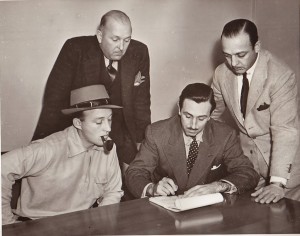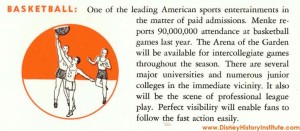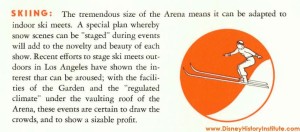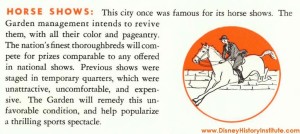 |
| Bing Crosby, Richard Bailey, Walt, Everertt Crosby – Feb 9, 1939 – photo scan from Tagtoonz |
Walt’s First Park
Part 2 – The Project Begins
by Todd James Pierce & Paul F. Anderson
In December 1938, when asked about his interest in Hollywood Sports Garden, Walt Disney explained, “I went into it as a form of diversion.” But as 1938 dissolved into 1939, the Garden was far from a diversion; it was one central focus of Walt’s life.
Walt, himself, was primarily responsible for fundraising—making initial contact with celebrities and executives at other studios for possible involvement in the private club. The business of membership sales, however, fell to two employees recently hired by Hollywood Sports Garden.
Zack Farmer, who had experience in project development, worked closely with the architectural office of Walker and Eisen to prepare “various drawings showing different views of the proposed structure,” which then could be used to solicit investment. These same drawings would also be submitted to college and professional sports organizations to pave the way for future partnerships.
Richard Bailey, newly hired as secretary and treasurer, would complete applications so the proposed corporation could sell stock and memberships in the private club. He would also prepare advertisements, create an investors brochure, organize board meetings, and work to finalize the lease with Cpt. Allan Hancock.
An oilman from Huntington Beach, M.M. McCallen serving as vice president, would help form connections between the Garden and local investors outside of the studio system.
Bing Crosby, it seems, did little—other than attach his name to the project to create interest and legitimacy. He was, without question, the most famous man on the board.
By January 20, Walt, with the assistance of Bailey, had assembled 14 men—almost all film celebrities—to serve as directors for the private club. The list included the actors Jack Benny and George Raft, who was also offered the position of vice president of the club. Also on January 20, Zack Farmer was formally hired as an employee of the Garden, as the proposed corporation now had money to offer him a salary.
As an employee, Farmer evaluated the proposed site. With experts, he checked the “condition of the soil,” reviewed zoning regulations, and examined access to the site by road and rail. One of the most important tests involved the ground composition. To save money, architects believed they could sink the arena 38 feet below street level, thereby allowing the earth itself to partially support the lower portion of the building. To quell concerns about these and other plans, in one memo, Bailey assured Walt that Farmer “has for twenty years or longer been connected with the most conservative and most business-like elements…[with his] work to be very detailed.” Under Farmer, the suitability of the site was assured—yet he neglected to build any support within the Gilmore Island community itself. His previous projects—such as the Olympics—had never necessitated community outreach to ensure that local residents and businesses viewed his efforts in a positive light. Likewise, Farmer never reached out to the owners of the Pan Pacific Theater and the Gilmore Stadium, assuming that they would see the new project as a boon to the region.
 |
| HSG Investors Brochure – 1939 |
On February 9, Walt signed the papers to incorporate the Garden—papers that specifically stated that Walt Disney, though a significant investor, would have “no personal liability” for the Garden or the lease itself. That same day—after a satisfactory inspection of the land—Walt Disney, as president of the Garden, signed a 50-year lease on the Hancock property, thereby assuring a strong location in the desirable center of Gilmore Island. Hancock would countersign the lease four days later, finalizing the arrangement on February 13.
At this point, Walt and Farmer clearly believed that the surest path to success was to focus on fundraising—essentially, to sell memberships in the private club and sell stock in the corporation. They planned to sell 750 lifetime private memberships in the club, which, at $1,000 apiece, would raise $750,000—roughly half the money necessary to develop the land and build the sports complex. Beyond this, stock would be offered to the public at $100 a share. Funding, partly through the purchase of stock, would be provided by a few wealthy oilmen—such as Louis Lohman and Emmet Jones who had recently moved to the Golden State. One can assume that, with sufficient capitalization, Walt and Farmer intended to secure a bank loan to complete construction. To make these sales, Walt and Farmer—along with Gunther Lessing and Richard Bailey—spent the rest of February and most of March developing materials to showcase the wonders of Hollywood Sports Garden.
In terms of athletics, they believed the Garden could present both collegiate and professional basketball, boxing and wrestling, bicycle races, hockey, track and field events, even horse shows. In terms of entertainment, the Garden could host ice ballet, rodeo, circuses, and other traveling shows. In terms of public recreation, the Garden could offer ice skating, roller skating, dancing and billiards. Farmer believed that, toward the back of the property, they could erect a separate building that would house 42 bowling lanes—enough to assure “the Southland of its first A.B.C pin classic.” But the most unusual event slated for the Garden was indoor skiing.
 |
| HSG Investors Brochure – 1939 |
The sheer size of the arena would allow it to be used for indoor ski meets, with man-made slopes and plywood ramps. During one planning session, held in oilman Louis Lohman’s office, Zack Farmer was asked if the building had enough height for indoor ramps and snow hills. “Yes,” he replied, “There is a 125-foot clearance…We can put blowers up there and drop a snow storm during the meet.”
Another person asked: “Is there any indoor place doing it?”
“Yes,” Farmer replied again, “Philadelphia Stadium.”
During this same meeting, Farmer speculated that they could rent their facilities out to trade shows at $1,000 per day, for perhaps as many as sixty days per year. “That’s not an exaggeration,” he continued. “There are automobile shows, housing shows, etc. We have 35% more floor space than the Pan Pacific.”
Again, Walt asked about equestrian events—something that would bring in his old polo friends: “Didn’t the horse events go pretty well?” Walt said.
 |
| HSG Investors Brochure – 1939 |
“Oh, yes,” Farmer added, “The bigwigs here for years had what they called the Los Angeles National Horse Show Association in the old Ambassador Auditorium. That is a firetrap out there—a small dingy little space…The California Horse Show Association will have its big show in San Francisco. [But LA could have its own show.] You can assimilate all the equestrian events [here for] the Olympic Games.”
As the meeting progressed, the men explored the value of radio rights for sporting events held at the Garden. They investigated the possibility of selling footage to newsreel companies—even film rights for big events, such as boxing. “When our plans get to the right point,” Farmer said, “I want to pick a committee of three-to-five very carefully select-technical men out of the [film] industry to…tell us what installations they want in the basic design in lighting, juice, etc., so they can turn this place quickly into what they need to take pictures.”
With this plan and also a new brochure highlighting the architectural framework of the Garden, Walt, Farmer and the other men approached local universities and sports associations. Walt, himself, approached the coaching staff at USC. Sam Berry, the lead basketball coach, liked the idea of a modern, large arena in Los Angeles. “I remember that last year at the Pan Pacific the games were always crowded,” Berry commented, “but this year scarcely anybody can force themselves to go to that dismal morgue [called] the Olympic.”
With support building for the Garden, Walt believed that he could probably assemble the necessary funding in a month or two.
On Wednesday, February 23, Walt called a 7pm meeting with the board at Perino’s, an elegant restaurant that was a second home to both Hollywood celebrities and local politicians. Unlike most restaurants, Perino’s wasn’t simply filled with tables: the luxurious interior also held sofas and club chairs. The establishment looked more like the gathering room at a mansion than a bistro. The agenda, it seems, was primarily structured around planning a large sales dinner for the following month, an event that would be attended by hundreds of potential investors and members. At this time, the board believed that the quickest way to “start the ball rolling” was to “go after the easiest money first,” which meant inviting “friends of officers, directors, and sponsors” to join the private club or purchase stock. These “friends” would likely be members of Hollywood’s elite, thereby solidifying the private club as an organization primarily filled with “men of high caliber and appearance” from the movie business.
Five days later, Walt met with his executive planning board—Emmett Crosby, Farmer, Bailey, Lohman, etc.—in his studio office. They felt it would be a good idea to erect “large signs staking out the [Hancock] property” to advertise the Garden. Even though they couldn’t afford to break ground, they believed it might be wise to give the “general appearance of construction” to create the illusion that the project was muscling ahead. Much of the strategizing, however, was still devoted to fundraising. The board felt it might be a good idea to incentivize sales—such as offering “one non-participating life membership in the Garden Club” for the purchase of five thousand dollars worth of stock. Another suggestion: board members should give “dinners or luncheons for their friends” to discuss the Sports Garden. The board members looked over operating costs—the cost of salaries, office space, etc.—as the money for expenses was almost surely being paid, at least in part, with the board’s personal funds.
As they worked through these possibilities, the mood in the room was optimistic—even expansive. They reviewed the graphics and text for the sales brochure, soon to be printed, and discussed other items that might be placed in the sales kit. The large goal—all of these men must have known—was not these small friendly luncheons with three or four possible investors, but the big dinner presentation Walt had discussed the previous week. That presentation, now, had a location and a time: it would be held in the Colonial Room at the Ambassador Hotel on Wednesday, March 29. This presentation, they knew, was their best chance of quickly raising enough money to begin construction.
Swing back next Monday for Part Three…in which Walt and his team try to find the money to build HSG. See you then. Post up your comments below. –TJP
PS We are running this series simultaneously on our podcast–click here to subscribe.

Recent Comments